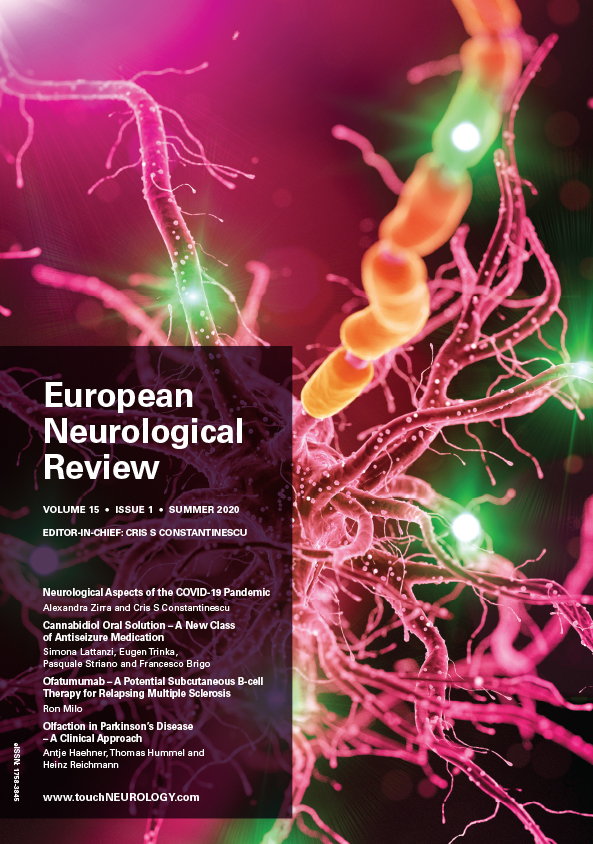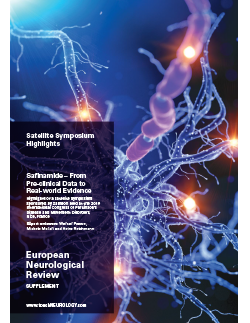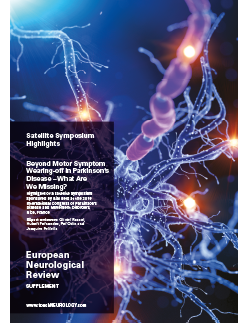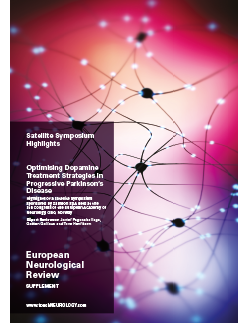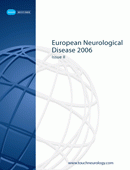
EUROPEAN NEUROLOGICAL DISEASE – VOLUME 1 ISSUE 1 – SUMMER 2006
Advisory Panel
In addition to the panel members below, Touch Briefings would like to thank Tamás Dóczi Past Vice President, European Association of Neurosurgical Societies (EANS) Bruno Vellas Principal Investigator, European Alzheimer’s Disease Consortium (EADC) Mary G Baker President, European Federation of Neurological Associations (EFNA)
Foreword
Neurology developed as a clinical speciality with close contacts with biology and similarities with internal medicine. Psychiatry matured under the impact of how socioeconomic, familial and interpersonal relationships can influence the human mind. For a long time, the two specialities drifted away from each other, but the progress in functional magnetic resonance imaging (MRI), improved […]
News Round-up
Alzheimer Europe Demands Access to Drugs for Patients Alzheimer Europe is calling for the National Institute of Health and Clinical Excellence (NICE) to revise its preliminary recommendations for the treatment of Alzheimer’s disease (AD) to allow patients at all stages of the illness to have access to drug treatments. The discriminatory nature of the current […]
Papers Abstracts
Global prevalence of dementia: a Delphi consensus study Ferri C P, Prince M, Brayne C et al. Lancet (2005);366: pp. 2,112–2,117
Regulatory Issues
In December 2005, a conference was held in Brussels to stimulate an informed debate on stem cell research in Europe and the ethical, religious and political aspects of such research. The particular aim of the conference was to allow patients (and others) to become better informed on all aspects of this sensitive issue and to […]
Parkinson’s Disease
Parkinson’s disease (PD) is a chronic, progressive neuro-degenerative disorder, characterised by rest tremor, bradykinesia, rigidity and postural instability. The incidence of the disease increases with age, with the majority of patients experiencing onset after the age of 50. A significant number of patients, however, experience onset of symptoms at a younger age and in 5–7% […]
Alzheimer’s Disease
In 1990, representatives of the Belgian, Dutch, Irish and Spanish Alzheimer and dementia associations met in Louvain, Belgium, to discuss the possibility of setting up a network of European Alzheimer and dementia associations, which should focus on the exchange of information, experiences and best practices between countries with similar social and cultural systems. European Projects
Alzheimer’s disease (AD) is a frequent brain pathology of the elderly, with a far more complicated aetiology than what was thought in the 1990s. The complexity particularly comes from the co-existence of two degenerating processes, tau aggregation and amyloid beta (Aβ) deposition, that affect polymodal association brain areas, a feature never observed in non-human primates […]
Epilepsy
It has long been recognized that seizures will be or will become refractory to pharmacotherapy in more than 30% of patients, and that localized related epilepsies are less likely to be controlled than the idiopathic generalized syndromes. Some of these patients will be offered epilepsy surgery or a vagal nerve stimulator. Many epilepsy sufferers will […]
Multiple Sclerosis
Several randomised clinical trials have clearly demonstrated that the immunomodulating drugs, human recombinant interferon beta (IFN-β) and glatiramer acetate (GA) are more effective than placebo in the treatment of relapsing-remitting multiple sclerosis (RRMS).1 These drugs are now the approved treatment for RRMS and clinical practice treatment guidelines have been issued. After many years of effective […]
Pain Management
The use of chronic narcotics in the management of chronic non-malignant pain (CNMP) is an important but extremely controversial subject. Hardy noted in 1991 that “there is no place for opiates in the treatment of chronic benign pain”.1 A year later, the American Pain Society (APS) survey of its physician members indicated that opioids are […]
Back Pain
Lumbar spinal stenosis, by definition, means narrowing of the lumbar spinal canal. It is seen in a congenital form, especially in chondrodystrophic dwarfs, but more than 95% of the cases are acquired and are of degenerative origin. In the congenital form, the pedicles are short, causing reduction of the anteroposterior diameter of the spinal canal. […]
Neurosurgery
Parkinson’s disease (PD) is caused by a progressive degeneration of dopaminergic cells in the pars compacta of the substantia nigra (SNc), thereby inducing a depletion of dopamine concentration at striatal level. The restoration of dopaminergic transmission by levodopa (L-dopa) has been used successfully for many years, but causes long-term motor complications. In this case, neurosurgery […]
Stroke
Stroke is the third leading cause of death worldwide and in developed countries, it is the leading cause of disability. In developed countries, the average age-adjusted incidence of stroke is 150 per 100,000 population per year and stroke-related mortality ranges from 50 to 100 per 100,000 population per year. The non-modifiable risk factors include age, […]
Stroke is the term applied to the sudden death of brain cells when a blockage or rupture of an artery impairs blood flow to the brain. Typically, a clot forms in a small vessel in the brain that has been narrowed due to long-term damage. Stroke may also result from: • a blood clot or […]
The development of stroke units has significantly changed the outcome of stroke patients – one-year mortality has decreased by 23%. The hospital stay has been reduced by six days on average and five out of 100 patients become more independent at home, while four more survive and one less needs to be transferred to a […]
Neurological disease remains, without doubt, one of the leading causes of both death and disability in modern society. In the majority of afflicted patients, the neurological sequelae are a result of cardiovascular disease (CVD). Consequently, prophylaxis of this disease can also be expected to have beneficial effects on the incidence of neurological disability. For example, […]
Neuropathy
Diabetic neuropathy is the most common neuropathy in industrialised countries. Considering that diabetes affects an estimated 177 million people worldwide (World Health Organization (WHO) 2002), more than 20 million people suffer from diabetic neuropathy with a remarkable range of clinical manifestations.1 More than 80% of the patients with clinical diabetic neuropathy have a distal symmetrical […]
Psychiatry
Bipolar disorder is an under-diagnosed and, when insufficiently treated, devastating illness.1–3 In contrast to unipolar depression, bipolar disorder seems to have a worldwide prevalence within a relatively narrow range. Multinational studies have revealed a lifetime prevalence rate of approximately 1.6% for bipolar I disorder,4 and for the spectrum of bipolar disorders classified as bipolar I […]
Forty years ago, after a spate of pharmacological discoveries, diagnostic confidence was rising in psychiatry. Textbooks of the time indicated that the work of Pinel, Kraepelin and Bleuler had laid the foundation for imminent and encouraging progress in clarifying the connections between aetiology (or at least pathogenesis), classificatory (diagnostic) labels and largely pharmacologically based therapeutic […]
The monoamine hypothesis has dominated research into the pathophysiology and pharmacotherapy of depression for a long time. This has led to the development of antidepressants that are now more selective than the early tri- and tetracyclics from which they have evolved. Alternative hypotheses such as those involving adult neurogenesis or components of the hypothalamic–pituitary–adrenal (HPA) […]
Schizophrenia
Schizophrenia affects approximately 1% of the population worldwide and, in around 80% of those, it is a lifelong, disabling disorder. Both genetic and environmental factors contribute to the development of the disorder. The symptoms of schizophrenia can be classified into three groups: • positive symptoms (e.g. hallucinations and delusions); • negative symptoms (e.g. anhedonia, social […]
Reference Section
The use of chronic narcotics in the management of chronic non-malignant pain (CNMP) is an important but extremely controversial subject. Hardy noted in 1991 that “there is no place for opiates in the treatment of chronic benign pain”.1 A year later, the American Pain Society (APS) survey of its physician members indicated that opioids are […]
Insomnia is a common condition characterised by difficulty falling asleep, increased night-time wakefulness or inadequate sleep duration. Insomnia can result in daytime consequences, including tiredness, difficulty concentrating and irritability, as well as increased healthcare utilisation and reduced work productivity, lower quality of life or quality of social relationships and decrements in memory, mood or cognitive […]
In the field of clinical psychopharmacology, substantial progress has been made in the drug treatment of schizophrenia with the advance of novel/atypical antipsychotics. Neuroleptic medication is the most important part of the treatment regimen for schizophrenic patients. The efficacy of neuroleptics in the acute and long-term treatment of schizophrenia is well proven and the effect […]
Technology & Services Section
Microelectrode recording (MER) began in the research laboratory as a tool for scientists to record the activity of individual neurons in the brain. The process was eventually introduced into a clinical setting and, in the 1960s, MER became an important device for target localisation in lesioning surgeries, such as pallidotomy and thalamotomy, used in the […]
Current pharmacological therapy for chronic pain and Parkinson’s disease (PD) is insufficient for all patients or disease stages. Chronic pain treatments may have side effects limiting their use and PD therapies can cause severe motor complications after only a few years. Using the body’s intrinsic electrical circuits, neurostimulation is an effective and well-tolerated alternative, with […]
Pressure-programmable shunt valves permit non-invasive readjustment of the opening pressure in an implanted shunt to respond to changes in cerebrospinal fluid hydrodynamics.1,5,8,10 Such valves are advantageous in patients with normal-pressure hydrocephalus,1,7–9 arachnoid cyst,9 complications caused by over-drainage of cerebrospinal fluid,5,9 and slit-ventricle syndrome;4,5 however, the magnetically adjustable valve setting may need readjustment after exposure to […]
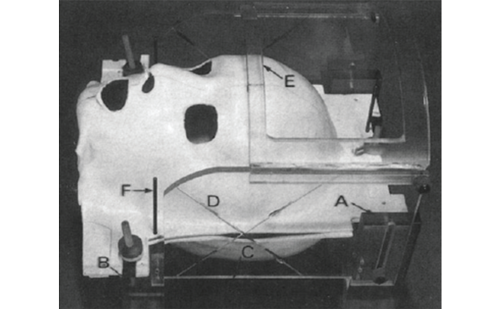
Trending Topic
Intracranial radiosurgery, no matter the means or methods of administration, is predicated on a core set of principles, including head immobilization and precise delineation of the treatment target. For some five decades after Leksell introduced the concept of stereotactic radiosurgery in 1951,1 rigid head fixation via an invasive device was an integral component towards these ends. […]
Journal Archive
European Neurological Review is a peer-reviewed, free-to-access, bi-annual neurology journal comprising review articles, case reports, practice guides, theoretical discussions, and original research. It features balanced and comprehensive articles written by leading authorities, addressing the most important and salient developments in the field of neurology in practical terms.
Latest articles videos and clinical updates - straight to your inbox
Log into your Touch Account
Earn and track your CME credits on the go, save articles for later, and follow the latest congress coverage.
Register now for FREE Access
Register for free to hear about the latest expert-led education, peer-reviewed articles, conference highlights, and innovative CME activities.
Sign up with an Email
Or use a Social Account.
This Functionality is for
Members Only
Explore the latest in medical education and stay current in your field. Create a free account to track your learning.



